Menu
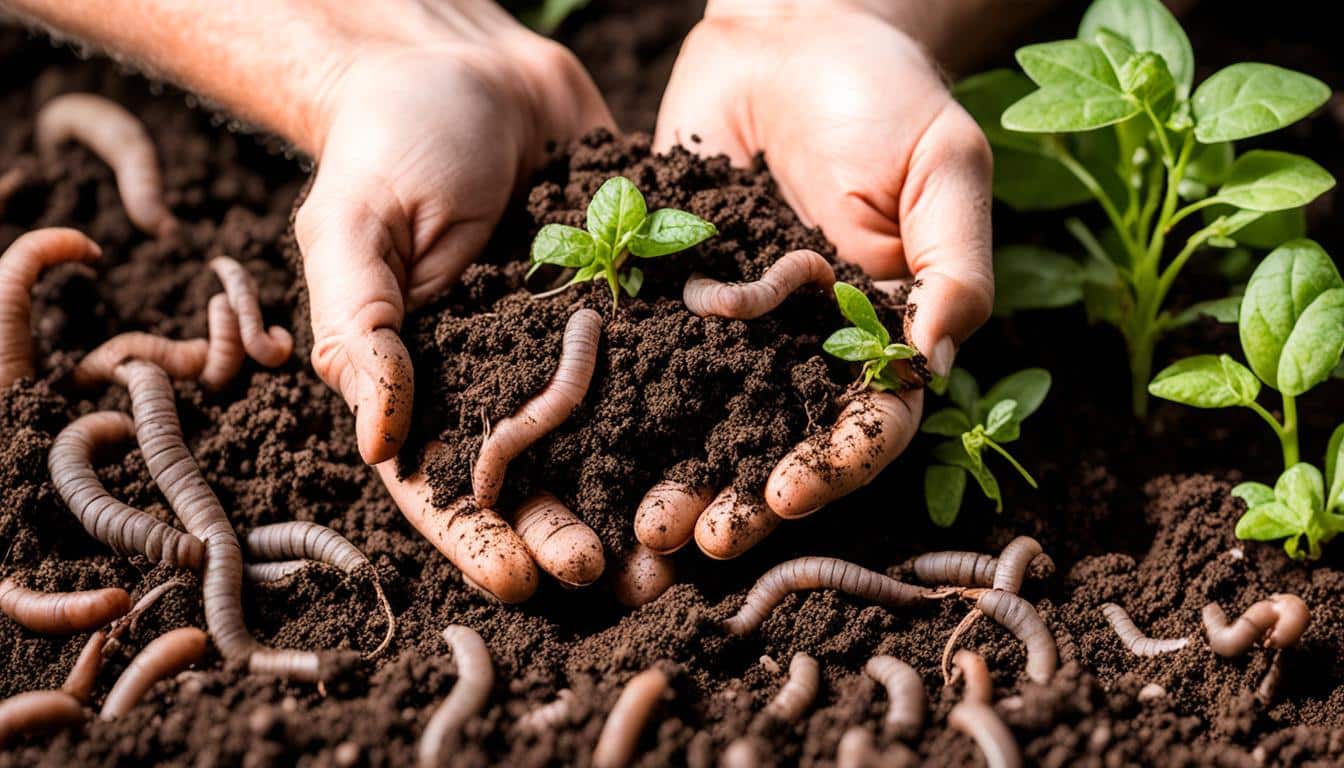
Did you know that almost half of soil compaction starts when you first plant something? This high number shows how important it is to improve the structure of our soil. When we start gardening, we often see our plants grow well at first. Then, they start to slow down. Sally noticed this in her raised garden beds.
The health of your garden depends a lot on the soil. Over time, the ground becomes tight and stops roots from growing deep. Adding things like compost and worm castings helps break this compaction. Biochar, on the other hand, is great for making soil drain better and hold more nutrients, especially in sandy areas.
Adding slow-release fertilisers and kelp gives plants the extra minerals they need to keep growing well. These steps make sure your soil stays healthy. This way, your garden will keep getting better because the soil is strong and full of life.
To have a thriving garden, it’s key to get soil right. We need to know about sandy, clay, and loamy soils. Each soil affects growing plants differently. So, we must use the right methods to keep our gardens healthy.
Sandy soil feels coarse and lets water run through fast. Its main feature is needing lots of water often. This soil type also needs regular feeding to keep plants happy. Knowing this helps make your garden flourish.
Clay soil packs together tightly and holds lots of nutrients. This can help your plants grow well. But, too much water leads to problem like roots not spreading well. It’s important to deal with waterlogging and compaction for your garden to do well.
Loamy soil, with its mix of sand, silt, and clay, is perfect for gardens. It holds water and nutrients just right. This makes it good for many plants. Using loamy soil means your garden can be full of life.
Knowing about sandy soil characteristics, clay soil benefits, and loamy soil gardening is key. It’s crucial for a healthy and fruitful garden.
Keeping soil healthy is very important for growing food and looking after our planet. Nearly all our food comes from the soil. So, it’s vital to keep it rich in nutrients and full of helpful bugs. This is key for making sure plants grow well.
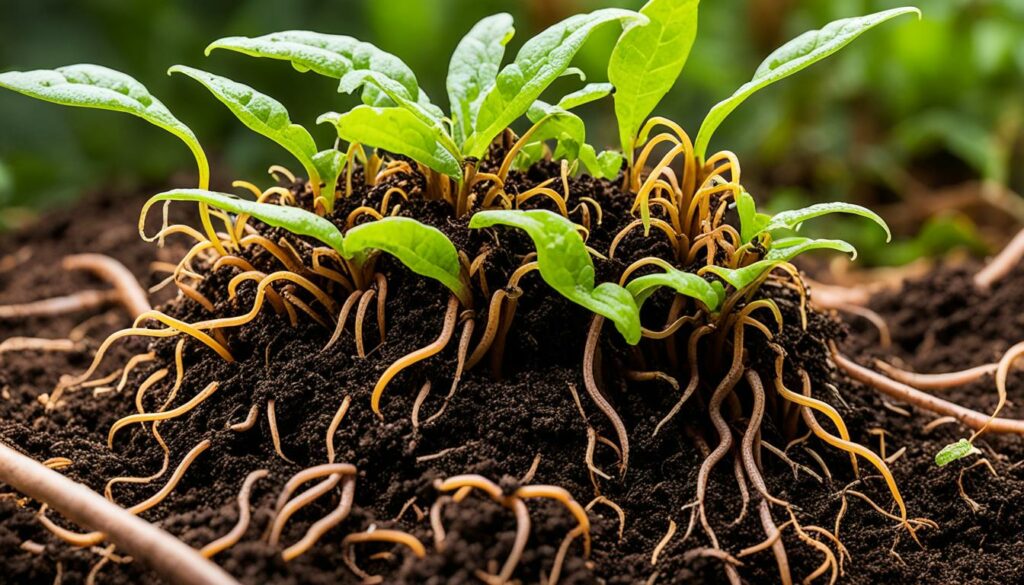
Good soil makes plants grow better by giving them the right nutrients and water. Beneficial bugs help plants by turning old plant stuff into food. If the soil has lots of carbon, it can hold more water and has more good bugs. This makes the soil better for plants to grow in.
A healthy soil environment can stop diseases and pests. It’s because good bugs beat the bad ones, protecting the plants. A balanced soil community helps plants fight off troubles and reduces the need for chemicals.
Healthy soil keeps water and nutrients ready for plants. It holds water well and stops it from running off. This protects soil from washing away. The good bugs also keep the plant food around, helping the plants stay healthy without using more chemicals.
It’s really important to make our soil better. If we don’t, we might lose it all in just 60 years. Over half of the soil used for farming now is in poor shape. We can save the soil by growing more things, disturbing it less, and keeping it covered by plants or other things. This way, we can keep our land fertile for the future.
| Aspect | Healthy Soil | Degraded Soil |
|---|---|---|
| Nutrient Availability | High | Low |
| Organic Matter | Abundant | Scarce |
| Microbial Activity | Vigorous | Weak |
| Water Retention | High | Low |
| Pest and Disease Resistance | Strong | Weak |
Adding organic matter is key to making soil better. Items like compost and manure are great for this. They make the soil richer and help plants grow strong and healthy. Also, they create a good place for small organisms to live.
Compost works well for all kinds of soil. It makes sandy soil keep more water. And it helps clay soil drain, so it doesn’t get too hard.
Using compost regularly is good for soil health over time. It adds food for plants slowly. Plus, it helps with making the soil more alive, which is great for plant roots. That’s crucial for growing vegetables that need a lot of nutrients.
It’s easy to see why adding organic material is important. It keeps the soil rich and the plants looking good. By doing this regularly, the garden will be full of life and strong soil.
Improving soil structure is key for a lively garden. Using different methods boosts soil’s nutrients and fights issues like compaction and erosion. Let’s look at composting, mulching, and how biochar can make a big difference.
Composting is a top technique for changing soil structure. When we mix compost into the ground, it brings in good bacteria and nutrients. These aspects really lift soil health.
It also helps soil hold onto moisture and supports root growth. That’s why it’s a must for everyone who loves their garden.
Mulching is great for keeping soil moist and stopping weeds. It lays down a natural barrier that prevents water from evaporating too quickly. This way, plants stay well-watered.
The materials used for mulch break down over time. They feed the soil and keep it in good shape. This shows how important mulching is for caring for the soil.
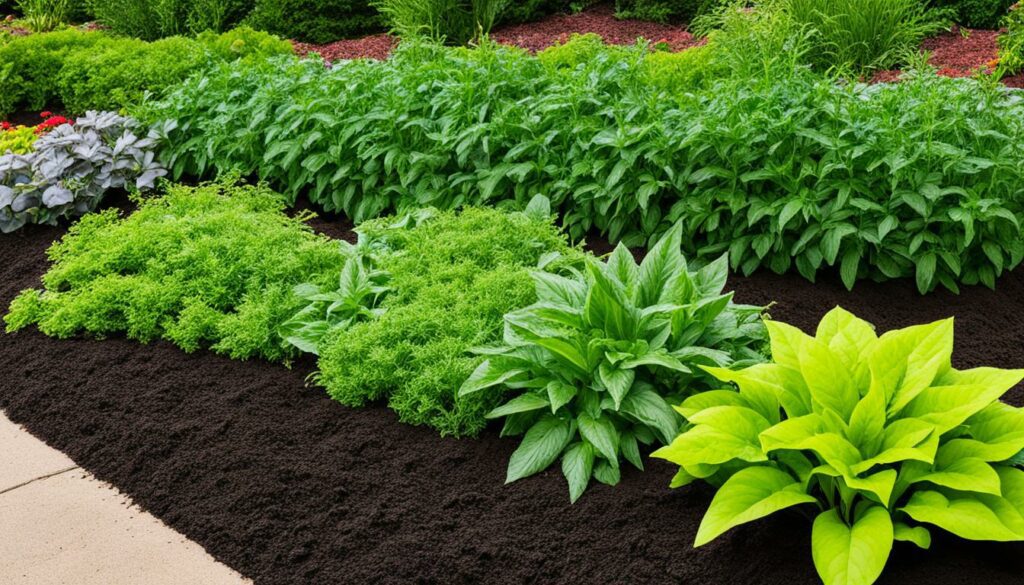
Biochar is becoming known for helping soil structure in many ways. It makes the soil airy and helps it hold water better. This means a better home for good bacteria and a healthier ground overall.
Biochar also fights soil compaction. It keeps roots strong and supports the plant’s health.
A mix of composting, mulching, and biochar is a winning strategy. Together, they boost soil health and make for a great gardening space.
Fertilisers are crucial for making soil fertile. They keep the soil full of important nutrients all year. With lots of crops grown, soil often loses its nutrients. Fertilisers help by adding these back.
Organic fertilisers release nutrients slowly. This is better for the soil than quick boosts from chemicals. In fact, the first year sees a 50% increase in nutrients from organic fertilisers. This makes the soil better for plants to grow well.
Unlike chemical fertilisers that can harm the soil, organics make it healthier. They do this by improving the soil’s natural balance and helping with water retention. By using organic fertilisers, soil erosion is less, and crops grow better.
Kelp is amazing for fertilising. It’s packed with nutrients that plants love. This leads to strong, healthy plants that can fight off diseases. Dr. Christopher Trobacher says mixing kelp with other fertilisers gives the best results.
Kelp makes it easier for plants to get what they need from the soil. This supports healthy plant growth. It also boosts the soil’s overall health, making plants tough against bad weather.
Adding kelp to organic fertilisers makes a perfect mix for plants and the soil. This mix feeds plants well over time, so there’s less waste and harm to the environment.
Cover crops are key in making soil better. They do a lot for soil health and structure. These crops stop soil from being carried away and help the soil hold more nutrients. This all means the ground is better for growing plants.

Many types of cover crops meet different farming needs. Plants like hairy vetch are great at making nitrogen. They can give from 30 to 60 percent of the nitrogen that future crops need. Austrian winter peas, hairy vetch, and NITRO alfalfa can even provide all the nitrogen that potatoes need.
Also, plants with lots of roots, like rye and barley, can take in too much nitrogen. They can use up to 71 pounds of extra nitrogen per acre in just three months. Rye, for example, can get rid of all the leftover nitrogen in a corn field. This keeps nutrients from washing away, helping the soil stay good for growing.
Mixing crops in a smart way, like using cover crops, has lots of pluses. Rotations like corn>rye>soybeans>wheat>hairy vetch can save money on pesticides. They also earn as much as the usual crop rotations but with cover crops in between. Also, using different plants one after the other, like malting barley>cover crop radish>sugar beets, can drop the number of harmful pests by a lot.
Adding cover crops to growing plans helps the soil in many ways. Plants with different kinds of roots can make the soil rich again and balance nutrients. For example, medium red clover with oats and hairy vetch can do the job of 65 to 103 pounds of fertilizer per acre in a year.
| Cover Crop | Benefits |
|---|---|
| Hairy Vetch | Boosts corn yield, significant nitrogen fixer |
| Austrian Winter Peas | Provides up to 100% of required nitrogen for potatoes |
| Medium Red Clover | High fertiliser replacement value with oats |
| Rye | Effective nitrogen scavenger |
| Malting Barley | Reduces sugar beet cyst nematodes |
To get the most out of cover crops and crop rotations, pick mixtures of plants. These mixtures help the soil keep its structure and add organic matter. This is important for the soil to stay good for growing crops for a long time.
A garden’s health relies on good soil drainage. Bad drainage can cause water to stay and harm roots. The soil in towns and cities often lacks good drainage. This is because it’s been changed and has less natural material.
To know if your soil has poor drainage, look for certain signs. These include water staying on the surface for long and plants not growing well. You can easily check how well your soil drains by watching water move through it. If it drains slowly, your soil might be compact or have too much clay.
One way to better drainage is broad-forking. It uses a special tool that’s gentle on the soil. This method helps air and water reach the roots better. It is great for soils that hold water too much, especially those with lots of clay.
Biochar is also good for improving drainage. It’s a special kind of charcoal that makes soil airy and keeps moisture in. When you add biochar to your garden, it keeps the soil from getting too hard. It also makes the soil rich in materials that help plants grow. This is very good for healthy roots.
By taking these steps, your soil will drain better. This makes your garden a better place for plants to grow. Whether you choose broad-forking or use biochar, these methods lead to a flourishing garden.
Checking your soil is key for garden lovers. It tells us about soil’s health and what plants need to thrive. By testing your soil, you can make it perfect for plants. This way, they get the best chance to grow well. Testing the soil often highlights if there are any nutrient problems. This helps gardeners know what the plants need more of.
The pH of the soil matters a lot. Most plants in the Western United States prefer a pH between 6.5 and 7.2. If it’s too high, adding elemental sulfur can help. For low pH soils, Fast Acting Lime can make it better. Getting the pH right is a big step towards making the soil ideal for plants.
Knowing the nutrients in your soil is also important. Tests show if nutrients are low or high. It’s best to add fertiliser for those that are low. This avoids adding too much of what the soil already has plenty of. For soils in Virginia, extra organic matter can help a lot if it’s under 2%.
“Regular soil tests, every 3 years, help to see soil changes and choose the right actions.”
Let’s look at pH and the changes you can make:
| Soil Condition | pH Range | Recommended Amendment |
|---|---|---|
| Ideal Plant Growth | 6.5 – 7.2 | – |
| High pH | Above 7.2 | Elemental Sulfur |
| Low pH | Below 6.5 | Fast Acting Lime |
To keep the soil rich, use the right fertilisers and add lime when needed. These are given as pounds needed for a certain area. Compost is also great for the soil. Use about a 5-gallon bucket per 100 square feet yearly or each time you till. This keeps the soil in good shape.
By regularly testing the soil and keeping an eye on the nutrients, you can have a lively garden. This will make sure your plants are as healthy as they can be.
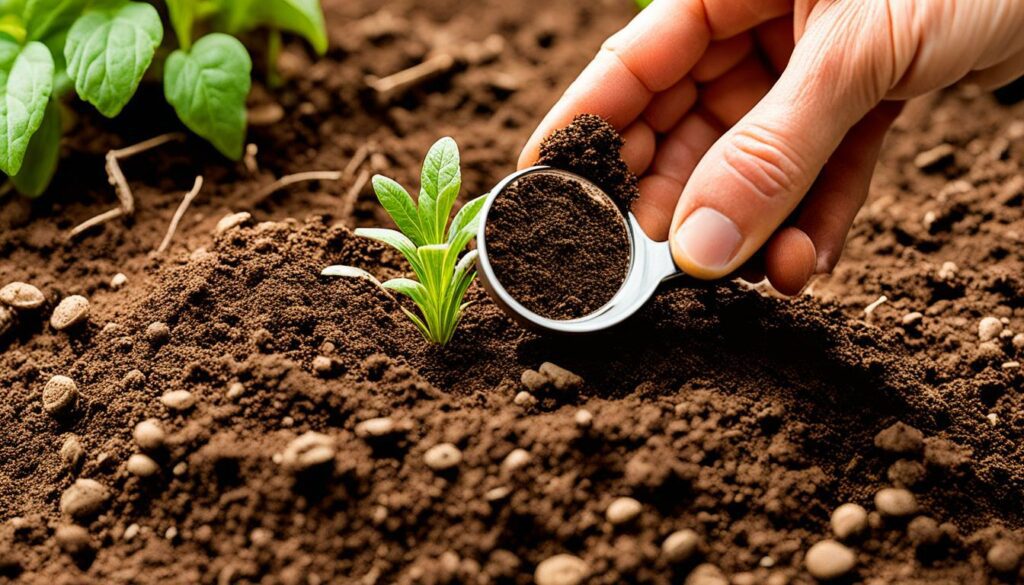
Compacted soils are becoming a serious issue, especially as rain levels and farm equipment size increase in areas like Minnesota. Good soil health is vital for plant growth. It’s important to notice if the soil is hard to dig into and plants are not growing well.
Hard soil that water can’t get into, and plants that aren’t growing well, are signs of soil compaction. Large machines and a lot of tilling make it worse. This happens because less space for water and air is left for plants. University of Minnesota Extension says soil that lets water, nutrients, and air flow helps stop compaction.
To fix hard dirt, we use things that add air or break it up. Adding things like compost helps the soil. It makes it better for tiny living things and helps plants. Aerating tools like forks or machines are good too. They break up the hard soil without ruining its natural balance. For really tough soil, machines like broadforks can help a lot, making water and air move better.
Changing which plants grow where is also good for the soil. Plants with different root depths stop the soil from getting too hard. This lets water and roots move more easily. If one plant can’t grow well in hard soil, another with deeper roots can help open the soil up for both.
| Technique | Benefit |
|---|---|
| Organic Matter Application | Enhances soil structure, promotes microbial activity |
| Garden Forks | Mechanically opens up soil, improves aeration |
| Broadforks | Loosens soil, improves water infiltration |
| Crop Rotation | Prevents compaction, maintains soil health |
To solve hard soil, we use many strategies. Mixing aeration tools with smart crop choices can make soil better. This leads to happier plants and a healthier garden all round.
Crop rotation is a key method in farming that boosts soil health. It does this by swapping crops each year. When farmers plant different crops during different seasons, the soil stays healthier. Not only that, plants grow better too.
Rotating crops improves soil structure. Each type of crop has roots that work the soil in different ways. For instance, plants like alfalfa and sunflowers have deep roots. They can break up hard ground, making it easier for water to soak in.
This makes it easier for other plants to grow well too. Adding mycorrhizae to the soil through crop rotation makes it even better. This fungus creates small channels in the soil. These help water and nutrients move around more effectively.
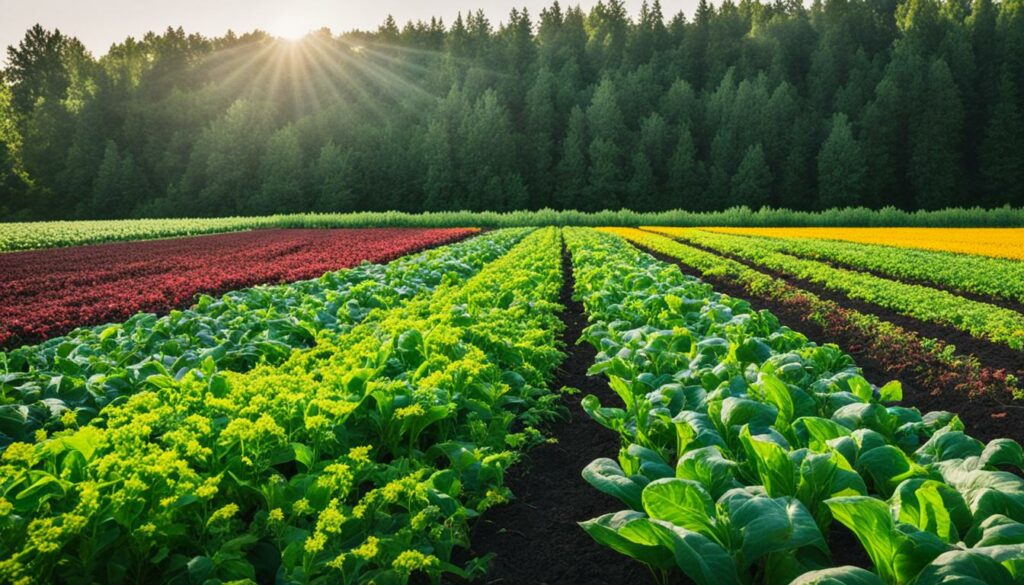
Crop rotation is also great at keeping pests and diseases in check. By changing the crops, farmers stop these problems from becoming big. For example, swapping between legumes and cereals each year can greatly reduce diseases in the soil.
Science tells us that using crop rotation leads to better corn harvests. In a two-year crop change, corn from the second year was 29% better. It shows how well crop rotation works in fighting pests and diseases.
Having many different crops around stops pests from becoming a big issue. This means farmers don’t have to use as many chemicals. That’s good news for the farm’s budget and the planet, as fewer chemicals are used.
Crop rotation saves money in other ways too. When farmers rotate crops, they can cut down on the amount of fertiliser and pesticides they use. It leads to bigger profits and more crops to sell.
For example, using a variety of crops in a four-year cycle can boost corn production by 48%. This shows how smart crop rotation can be for farmers.
| Year | Crops | Yield Improvement | Cost Reduction |
|---|---|---|---|
| Year 1 | Corn | 29% | 5% |
| Year 2 | Oats | – | – |
| Year 3 | Hay | – | – |
| Year 4 | Legume | 48% | 15% |
The benefits of crop rotation go well beyond just getting more crops. It also helps protect the soil in the long run. Plus, it keeps nutrients from running into our waterways. By rotating crops, farmers are supporting the health of the planet as well as their own farms.
Permaculture links our actions with nature to build strong, everlasting systems. By understanding ecological succession, gardeners learn to let soil and plants grow naturally. This helps the soil become better for plants and supports many different life forms.
Ecological succession shows how an area’s plants and animals change slowly over time. It not only heals the soil but also makes a home for many species. Using this idea can make gardens better, as plants and soil life work together well.
Mulch and compost are key in permaculture. Mulching cuts water loss by 70% and prevents soil from washing away. Meanwhile, composting makes soil up to 75% better. Both help soil grow by giving nutrients and letting helpful bugs live, making gardens healthier.
Earthworms play a huge role in permaculture as they move through the soil. They make it easier for air and water to get into the soil. Also, the earthworm droppings, called castings, help soil particles stick together better. This makes plants grow stronger because the soil gets more organic matter from these activities every year.
| Permaculture Techniques | Benefits |
|---|---|
| Ecological Succession | Restores soil health and biodiversity |
| Mulching | Reduces water evaporation by up to 70%, controls erosion |
| Compost Application | Improves soil composition by up to 75% |
| Natural Tillage by Earthworms | Enhances aeration, drainage, and soil aggregation |
Mulching is key to keeping gardens healthy and sustainable. A layer of material over the soil does a lot for soil health and garden success. It’s especially good because it breaks down slowly, feeding the soil with nutrients.
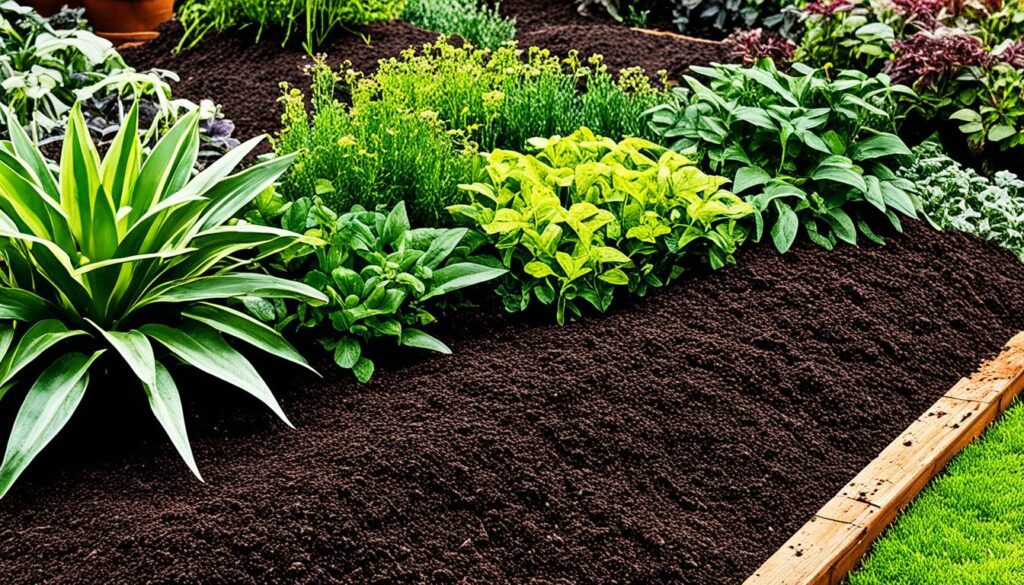
Mulch is great for keeping moisture in the soil. It stops water from evaporating, which is good for plant roots. This means you don’t have to water as often, making looking after your garden easier.
It also stops weeds from growing. Because it blocks the sun, it keeps weed seeds from sprouting. This means less work pulling up weeds or using chemicals, and it keeps your garden healthier.
Adding mulch helps the soil’s tiny creatures too. When it breaks down, it becomes food for good bacteria and fungi. This helps plants grow strong and adds more nutrients to the soil.
Mulch acts like a blanket, keeping the soil a steady temperature. This is really helpful for plant roots, as they don’t get shocked by sudden changes. So, your plants can grow without stress.
Using mulch is also a smart money move for your garden. It’s cheap and brings a lot of long-lasting benefits. It’s way better than using lots of chemical fertilisers. Mulch is a vital part of any sustainable garden plan.
One more thing mulch does is stop the soil from washing away. It stops rain and irrigation from eroding the ground. This keeps your soil in good shape, which is essential for a healthy garden.
To wrap up, mulch is a winning move for any garden. It keeps the soil healthy, the plants happy, and you can save money. With good mulch, your green space can thrive for years to come.
Managing raised beds has its own difficulties, mainly dealing with soil quality and nutrients. The main issue is the fast use of vital nutrients. This makes it necessary to focus on improving the soil of raised beds.
Soil in raised beds needs careful attention to maintain plant health. Problems like soil compaction and low organic matter can harm roots and lower crop output. Adding organic matter regularly helps, but success depends on the soil’s type.
Keeping nutrient levels right in raised beds requires a mix of compost, biochar, and organic fertilisers. This mix improves soil, supports good bacteria, and keeps nutrients ready for plants. For example, adding compost at a rate of 8.33 cubic feet per 100 square feet can enhance soil’s nutrient content.
Manure-based composts, higher in nutrients than those from plants, are great for raising beds. They are rich in nitrogen and phosphorus, and more than that, they’re mostly inorganic. This means plants can use the nutrients easily.
Here’s a guide on different compost types and how they help in raised bed soil management:
| Type of Compost | Weight (Per Cubic Foot) | Primary Benefits | Usage Recommendations |
|---|---|---|---|
| Plant-Based Compost | 40 lbs | Low in inorganic nutrients, aids in organic matter buildup | Ideal for long-term maintenance and nutrient balance |
| Manure-Based Compost | ~40 lbs | High in nitrogen and phosphorus, quick nutrient release | Best for initial soil amendment and quick nutrient boost |
| Co-Composted Biochar | Varies | Enhances nutrient retention and microbe richness | Incorporate with organic fertilisers for balanced soil health |
To deal with raised bed gardening’s difficulties, focus on improving both nutrient levels and soil quality. These efforts can greatly boost your beds’ health and yield.
In improving garden health and success, managing the soil well is key. Gardeners can ensure their plants grow strong by choosing the right ways to improve the soil’s structure.
Soil aggregates are bunches of soil particles that stick together. They help keep water and air close to plant roots. Earthworms make tunnels that let roots go deeper, making the soil richer with their waste.
Good soil structure stops soil from washing away or getting too hard. Adding organic matter makes the soil better at holding nutrients and water. This material eventually turns into plant food.
Not digging the soil too much helps keep its natural clumps together. This protects against soil being washed away and keeps it alive with different small creatures. Having many types of plants stops weeds and bugs.
Cover crops and not digging the soil also help it stay strong. These plants stop the ground from being blown away and bring back important plant food. Together, these methods protect the soil so it can support plant life for a long time.
Biochar is great for the soil, making it better at holding water and fighting diseases. It also helps the environment by locking away harmful gases. Using things like a broad-fork and mulch along with biochar makes the soil even healthier and stronger.
So, a great garden needs to focus on its soil. Using natural ways to make soil better, like adding organic matter and biochar, helps a garden stay healthy and grow well year after year. Gardeners who pay attention to soil health see their plants flourish and their gardens become lively places all the time.
Improving soil structure leads to better air, water, and nutrients for plants. This means your plants will grow healthier and yield more. It also cuts down on soil compaction and helps roots grow better.
To upgrade your soil, use compost, manure, and biochar. Also, mulching and rotating crops help. These steps boost soil’s air, water, and nutrient content for root health.
Sandy soil is very coarse and drains quickly but lacks nutrients. It needs a lot of water and fertiliser. Adding organic matter helps it keep moisture and nutrients better.
Clay soil is good at keeping nutrients but drains slowly and gets hard. It can keep plants healthy with its nutrients. To improve it, add organic stuff to boost air and water flow.
Loamy soil, with sand, silt, and clay, is perfect for plants. It keeps water, is full of nutrients and air. This soil is great for many kinds of plants and is easy to care for.
Healthy soil provides plants with the food and water they need. It also gives them a place to grow stable roots. Good soil is full of tiny bugs that protect plants from diseases and pests.
Adding compost makes soil better for plants. It improves soil’s feel and helps it keep nutrients and water. Healthy soil is full of good bugs that help plants.
By making compost, soil gets more life and food. This makes the soil feel good and work better for plants. It makes roots grow deeper and hold more water and food.
Mulch keeps soil damp, stops weeds, and adds food to the ground. It makes the soil strong and stays as healthy as time goes by.
Biochar keeps air, water, and food in the soil for plants to use. This special charcoal is a home for good bugs. It stops soil from getting hard and empty of food for plants.
These fertilisers feed plants slowly to stop their food from washing away. They make soil keep feeding plants for a long time without getting sick.
Kelp gives plants important food and strengthens them against sickness. Using kelp with other foods makes the soil better at feeding plants.
Cover crops stop soil from washing away, make the food in it better, and help it breathe. They make the soil diverse and strong for plants.
Make the soil better at draining by letting air in and adding biochar. This helps water move away and lets plants’ roots breathe.
Testing soil tells you what plants need to grow strong. It makes sure the soil stays just the way plants like it, keeping them healthy.
Crop rotation helps the soil stay good, grows different plants, and stops sickness. It uses the soil in different ways, which is good for the ground.
Permaculture helps the soil by using natural ways to keep it clean and fluffy. It makes the soil recycle food and breathe. These are good for plants.
Mulch feeds the soil with things that slowly break down. This makes the soil alive with good bugs and food for plants. It keeps the soil wet and healthy.
Raised beds run out of food quickly, so you need to keep adding fresh compost and biochar. This keeps the soil full of life, which plants need to be healthy.